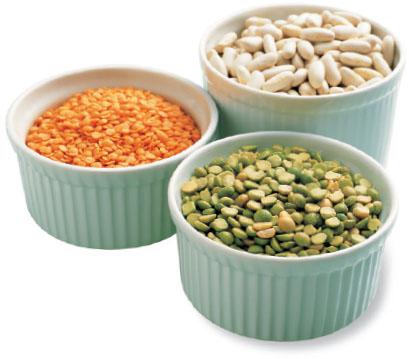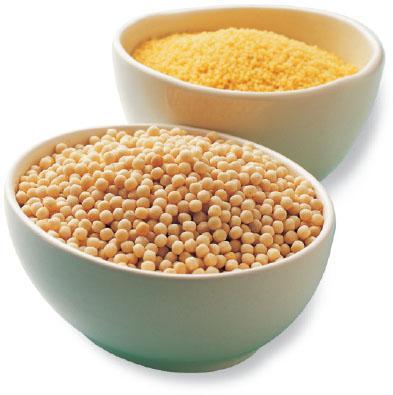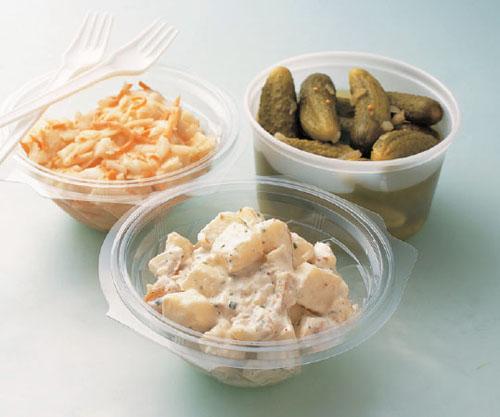Kosher and Traditional Jewish Cooking: Authentic Recipes From a Classic Culinary Heritage: 130 Delicious Dishes Shown in 220 Stunning Photographs (42 page)
Authors: Marlena Spieler

This golden cornmeal is widely used in Eastern Europe and is Romania’s national dish. It resembles polenta and can be eaten either soft and porridge-like, or spread out on a baking tray and left to chill in the refrigerator until firm, then sliced and fried or grilled (broiled). It is good eaten either hot or cold.
Mamaliga is eaten by everyone in Romania, whether they are Jewish or not. For breakfast, it is drizzled with honey or jam and served with sour cream; for lunch it is topped with cottage cheese or Brinza, a cheese similar to feta, and butter. It also tastes great with roasted (bell) peppers and tomatoes. Alternatively, for a meat meal, with a pot-roast and gravy, or grilled (broiled) beef patties or beef sausages.
This high-protein food is a good source of B vitamins. It is an indispensable ingredient in Eastern European dishes such as mushroom and barley soup, or barley with vegetables and butter (lima) beans. A small amount of meat is also sometimes added.
This is the partially milled grain of the whole wheat and is widely used in cooking throughout the Middle East. It comes in different sizes, from small and fine through to large. Bulgur wheat is sometimes eaten in place of couscous or rice, with savoury stews or soups.

Beans, split peas and lentils are rich in protein and can be added to stews to eke out a small amount of meat.
This grain-like staple actually consists of tiny pellets of pasta, though it is usually categorized as a grain. It has always been very popular with the Jews of North Africa and, when they came to Israel, they brought it with them, in various different sizes. It is easy to prepare and is usually steamed over a light and savoury spicy stew of vegetables, meats, fish or fruit. Many different types of couscous are available and they are cooked in different ways. Ordinary couscous is moistened with cold water and left to plump up. It is then steamed over a stew. Fast-cooking couscous only needs to be combined with boiling water, then heated through or left to soak.
Israeli couscous, a pea-sized toasted pasta, is cooked in the same way as pasta. It gives a succulent result and is very good in soups and fish dishes.
This is widely eaten by Jews throughout the world. Chelou is a classic dish of the Persian Jews. As it cooks, the rice at the base of the pan is allowed to form a crisp crust (
tahdeeg
), which is then stirred into the tender rice, providing a tasty contrast of textures. Sometimes, thinly sliced potatoes are also added.
Many Iranian Jewish specialities use chelou as their base, topping it with herby vegetable or meat stews. At Rosh Hashanah, Iranian Jews particularly favour rice. The many tiny grains of rice represent the many grains of happiness that are hoped for during the coming year.
These are eaten in great quantities by Sephardi Jews, and Eastern European Jews serve them to celebrate a Brit Milah. They are milled into flour and used as a thickener by Indian and Middle Eastern Jews, and are soaked and ground to make falafel, which is considered by many to be Israel’s national dish.
Broad (fava) beans and black-eyed beans (peas) are very popular with the Sephardim. Broad beans are very ancient and have been found at pre-pottery Neolithic B levels in Jericho. Black-eyed beans originated in Ethiopia about four thousand years ago and were recorded in Judea about 1500
BCE
(
BC
). Both are eaten in soups and stews. Dried broad beans are cooked and eaten with garlic, olive oil, hard-boiled eggs and a little tahini.
All types of lentil are made into soup, from split red lentils, which cook relatively quickly, to the superior tasting brown variety. Yellow and green split peas are also popular. In Genesis, the story is told of how Esau sold his birthright for a pottage of lentils.

Israeli couscous (in front) has much larger grains than regular couscous (behind).
Many different types of vegetables have particular significance in celebrations to mark religious festivals. For instance, at Rosh Hashanah, pumpkin may be served, its golden colour signifying prosperity. Green vegetables will be on the table, symbolizing renewal and happiness, while dried beans and peas signify abundance.
Carrots for Rosh Hashanah are cooked in honey to signify a sweet new year. In contrast, at the Pesach Seder, bitter herbs are eaten as a reminder of the bitterness of slavery. At the same time, Ashkenazim eat broad (fava) beans, since this was what the Israelite slaves were fed during their captivity in Egypt. When Ashkenazim celebrate Chanukkah, they do so with potato latkes.

Root vegetables such as carrots, turnips and beetroot (beets) are typical Ashkenazi staples.
Seven different types of vegetable are used by North African Jews to make one of their specialities, a soup, which represents the seven days of Creation, with Shabbat being the seventh day.
Every year, the new season’s produce is eagerly anticipated, and as each vegetable is tasted for the first time, it is customary to recite the Shehehayanu, a prayer of thanksgiving.
Years of struggle and poverty, when Eastern European Jews were hounded from place to place, and taxed to the limit, made them increasingly inventive as to how they prepared vegetables. Carrots, cabbages, beetroot (beets), onions and turnips may have been dull and heavy but the Jews favoured their strong flavours. They frequently pickled vegetables to improve their taste, and to preserve them through the long winters. Sauerkraut, pickled cucumbers and borscht all date from this era.
When Ashkenazi Jews from Poland and Russia migrated south, they discovered a wealth of new vegetables. Peppers soon became popular, partly because they pickled well, and could be dried to make paprika. Potatoes were eaten with great gusto because they were so tasty and filling, and aubergines (eggplants), which had made their way to Romania from Spain and Italy, became widely used. Tomatoes were not widely accepted for some time, as their red colour was the same hue as blood and there was some question as to whether or not they were kosher – which may account for the Ashkenazi speciality, pickled green tomatoes.
In the early days, raw vegetables and salads were not greatly appreciated by Ashkenazim raised in cold climates, where warming, filling stews were a necessity. However, radishes of several kinds were still enjoyed, along with raw turnips, cucumbers, raw onions and garlic. The young spring shoots of garlic were much prized, and were often eaten with dense black bread. Sometimes raw carrots were grated and eaten in salads, as were the young leaves of wild greens and herbs, although these were often cooked and eaten hot as well.
The Jews of the Iberian Peninsula had a much greater variety of fresh vegetables available to them than their northern neighbours. They were among the first Europeans to encounter corn, (bell) peppers, tomatoes and green beans, which were introduced from the New World, and they embraced them with enthusiasm. Jewish merchants helped to popularize these new vegetables by introducing them to the more remote parts of Spain and then, after their expulsion in 1492, to the wider world. Globe artichokes and pumpkins were reputedly brought to Italy by the Jews. So too were aubergines (eggplants), which were much valued for their meaty texture, particularly when meat itself was not available, or had to be omitted because of the presence of dairy foods.
Sephardi Jews have always been known for their love of vegetables. They add them to stews, pilaffs and soups. Because they cook with olive oil, vegetable dishes are
pareve
so may be served with meat or dairy. They are cooked simply, then dressed with olive oil and lemon juice.
Vegetables also make perfect partners for eggs. Sephardi specialities range from the North African turmeric-tinted potato omelette, a variation on tortilla, to the Sicilian spinach tortino and a Spanish-Syrian dish of aubergine with eggs and cheese. The repertoire also includes chakshouka, a delicious Arabian dish consisting of (bell) peppers, tomatoes and eggs.

Colourful warm weather vegetables such as (bell) peppers, globe artichokes and aubergines (eggplants) form the basis of many Sephardi dishes.
Potato salad, coleslaw, cucumber and onions, Russian salad, roasted peppers, Romanian aubergine (eggplant) salad and marinated mixed vegetables are just some of the vegetable offerings that can be found in the deli. Sauerkraut is another deli staple, while dill pickles are the star attraction. American deli kosher dill pickles are not made with added sweetening or vinegar, just brine with spices and lots of garlic. More recently, specialities from Israel such as baba ghanoush have become popular.

Tubs of coleslaw, dill pickles and potato salad are just a few of the delectable offerings found in the deli.